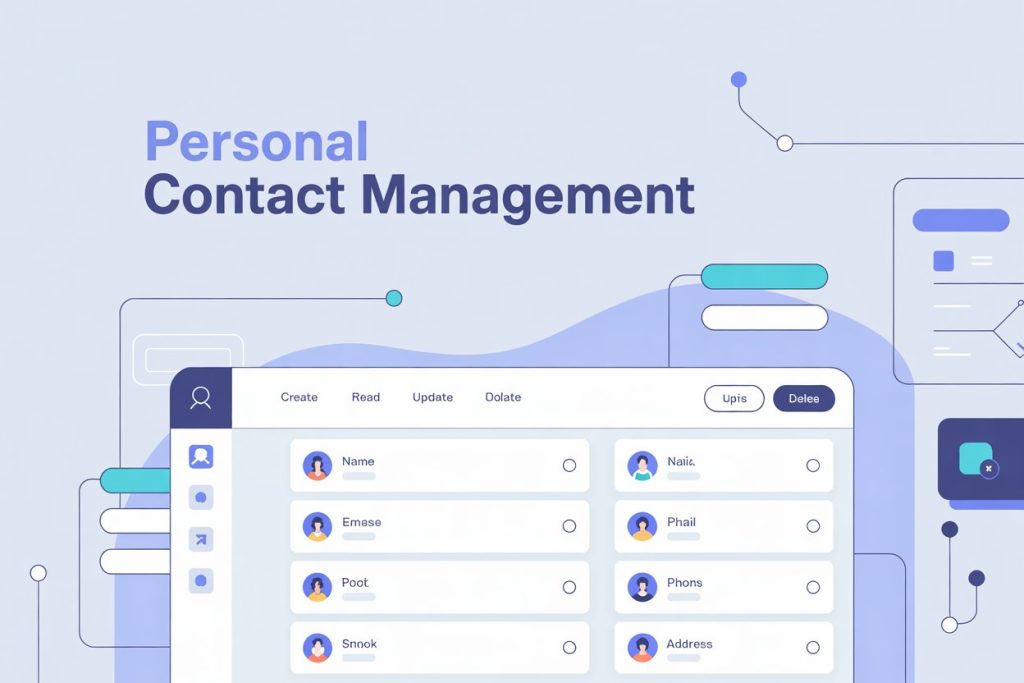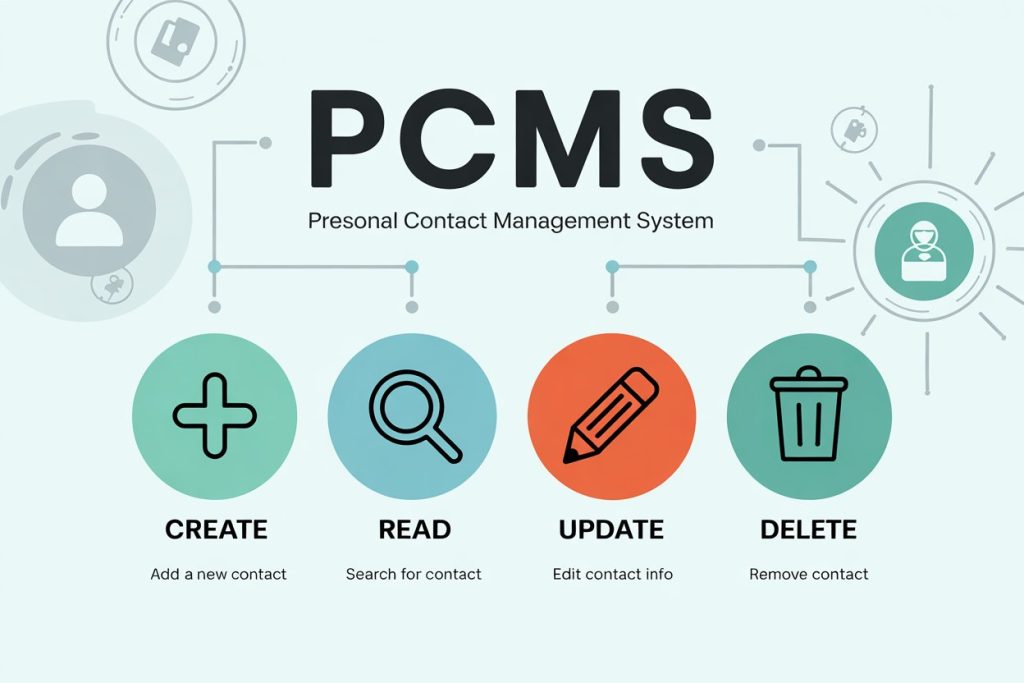In the digital age, managing personal and professional contacts efficiently is essential for both individuals and businesses. A Personal Contact Management System (PCMS) provides a centralized platform to organize, store, and retrieve contact information.
Whether it’s an essential address book or a complex enterprise-level system, the key to an effective PCMS lies in its ability to access, modify, and manage contact details quickly. The efficiency of these operations largely depends on the choice of data structure. The right data structure can significantly enhance the Create, Read, Update, and Delete (CRUD) operations, along with optimizing search functionalities.
In this article, we explore various data structures—arrays, linked lists, and hash tables—that can power a PCMS, examining their strengths, weaknesses, and use cases. By understanding these structures and their trade-offs, we can design a system that balances performance, scalability, and memory usage.

Key Functionalities of a PCMS
A PCMS must perform basic CRUD operations efficiently, enabling users to create new contacts, read or search for existing contacts, update details, and delete outdated entries. However, the ability to search for contacts quickly is arguably the most critical functionality, as it directly impacts the user experience. Let’s break down the essential operations:
- Create: Adding a new contact to the system involves inserting data (name, phone number, email, etc.) into the chosen data structure.
- Read: Retrieving a contact involves searching for specific information based on attributes like name, email, or phone number.
- Update: Modifying a contact’s information after it has been added to the system.
- Delete: Removing outdated or redundant contacts from the system.
While all these operations are important, search optimization is critical for large contact databases, ensuring fast retrieval of contact information.
Data Structures for Contact Management
A wide variety of data structures can be used to manage contacts in a PCMS. Each has its unique advantages and drawbacks, depending on the needs of the system. Let’s look at three common data structures used for contact management: arrays, linked lists, and hash tables.
- Arrays:
- Advantages: Arrays allow for fast indexing (O(1) time complexity) and provide contiguous memory allocation, which is efficient for accessing elements in a known order.
- Disadvantages: They are fixed in size, requiring resizing when the array is full. Insertions and deletions are inefficient as they involve shifting elements (O(n) time complexity).
- Use Case: Small-scale systems with fewer contacts and minimal updates.
- Linked Lists:
- Advantages: Dynamic memory allocation makes linked lists more flexible, supporting efficient insertions and deletions without the need for resizing or shifting elements (O(1) time complexity).
- Disadvantages: Searching for a contact involves traversing the entire list (O(n) time complexity), making them inefficient for large datasets.
- Use Case: Dynamic systems with frequent updates, but where search speed is not the primary concern.
- Hash Tables:
- Advantages: Fast lookups (O(1) average time complexity) through the use of a hash function that maps contact data to specific indices. This allows for quick access, insertion, and deletion.
- Disadvantages: They can be memory-intensive, especially if the hash table needs to be resized or if there are collisions. In the worst-case scenario (high collision rates), performance can degrade to O(n).
- Use Case: Large-scale systems requiring fast search and CRUD operations with scalable performance.
Top 20+ Best Angular Project Ideas of 2024 [with Source Code]
Implementing CRUD Operations in PCMS
The efficiency of CRUD operations largely depends on the underlying data structure. Here’s how these operations work with each of the data structures:
1. Create Operation
- Arrays: Inserting a contact requires finding space in the array. If the array is full, resizing is necessary, leading to O(n) time complexity.
- Linked Lists: Insertion is fast, with O(1) time complexity (assuming you know where to insert).
- Hash Tables: Inserting a contact is O(1) on average, thanks to hashing, although collisions may slow it down.
2. Read Operation
- Arrays: Searching requires iterating through the array (O(n) time complexity).
- Linked Lists: Searching involves traversing the entire list, resulting in O(n) time complexity.
- Hash Tables: With a good hash function, reading a contact is O(1) on average.

3. Update Operation
- Arrays: Updating requires finding the contact and modifying it, which is O(n) if searching is needed.
- Linked Lists: Similar to arrays, updates require O(n) time for searching, but O(1) for the actual update.
- Hash Tables: Updating is O(1) on average, after locating the contact via the hash function.
4. Delete Operation
- Arrays: Deleting an element requires searching (O(n)) and shifting the remaining elements (O(n)), resulting in O(n) overall.
- Linked Lists: Deleting a contact is O(n) due to the need to search, but the deletion itself is O(1).
Hash Tables: Deletion is O(1) on average, assuming good hash function performance and efficient collision resolution.
Search Optimization Techniques
Fast searches are the heart of a responsive PCMS. Here are key techniques for optimizing search performance:
- Hashing:
- Hash tables are designed for instant lookups. A good hash function ensures that contacts are mapped to unique indices, making searches O(1) on average.
- Indexing:
- Creating indexes based on specific contact attributes (like name or phone number) can significantly improve search times. Indexes organize data to allow for fast lookups, and when combined with data structures like B-trees, they can make searches even more efficient.
- Binary Search:
- If the contact list is sorted, binary search offers O(log n) time complexity for searching. Sorting the contacts initially takes O(n log n) time, but once sorted, binary search can quickly locate contacts by halving the search space.
Choosing the Best Data Structure for PCMS
Choosing the optimal data structure for a PCMS depends on factors such as speed, memory usage, and scalability. Here are the trade-offs:
- Arrays are ideal for small datasets with fast indexing and minimal updates.
- Linked lists are perfect for dynamically growing datasets with frequent insertions and deletions, but they sacrifice search speed.
Hash tables provide the best performance for large-scale systems where fast lookups and scalable CRUD operations are critical.
Conclusion
In designing a Personal Contact Management System (PCMS), the data structure chosen will significantly affect performance and usability. Arrays, linked lists, and hash tables each offer distinct advantages and are suited for different use cases, depending on the system’s needs.
- Arrays are great for smaller, static contact lists where fast access by index is important.
- Linked lists offer flexibility for dynamic lists with frequent updates but suffer from slower search times.
- Hash tables provide instant lookups and are the best choice for large systems that need to efficiently handle large amounts of data.
As technology evolves, additional features such as AI-powered searches, cloud integration, and natural language processing (NLP) could further enhance a PCMS, enabling smarter, more accessible, and scalable contact management solutions.
We encourage you to experiment with these data structures and develop your own PCMS. Building and optimizing your contact management system is an excellent opportunity to learn about software design, performance optimization, and scalability. Whether you’re working on a personal project or a professional application, the skills you develop will be invaluable as you continue to innovate.
Future Improvements
The future of PCMS systems lies in integrating advanced features to enhance their usability and efficiency:
- AI-powered searches: Integrating machine learning to optimize searches, predict user behavior, and even suggest contacts based on past interactions.
- Cloud integration: Cloud-based systems allow for synchronization across multiple devices, making your contact list accessible anywhere and ensuring seamless scalability.
- Natural Language Processing (NLP): Incorporating NLP can enable voice commands or more intuitive search queries, making the PCMS more user-friendly.
By building and experimenting with these ideas, you can develop a PCMS that evolves alongside technological advancements, offering users the best possible experience.